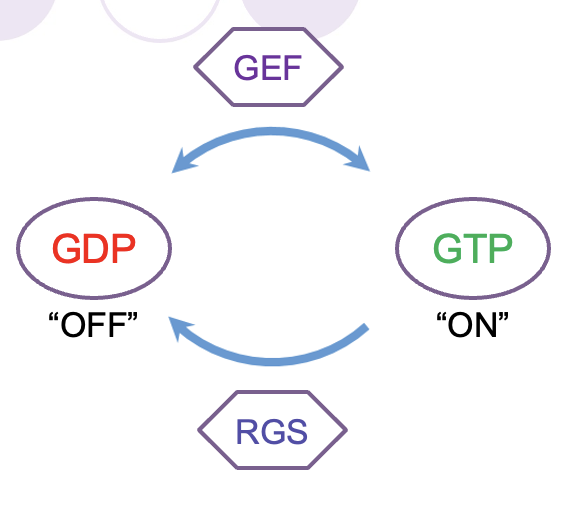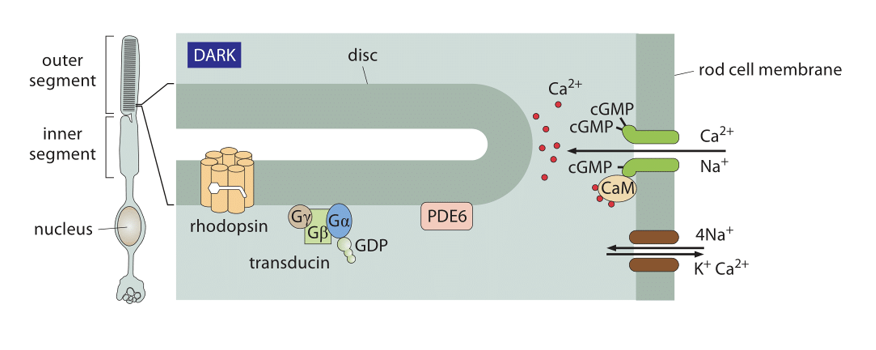2020 L3 G Coupled Protein Receptors
1/33
There's no tags or description
Looks like no tags are added yet.
Name | Mastery | Learn | Test | Matching | Spaced |
|---|
No study sessions yet.
34 Terms
Signalling Pathway
Signal > Receptor> Transduction Cascade > Targets < Response
Robert Lefkowitz and Brian Kobilka
Nobel Prize Winners for Chemistry 2012, did research on β-andrenergic receptor that provided insight into function and structure of GPCRs
GCPRs
G coupled receptors
Signal receptors for molecules e.g. hormones, neurotransmitters
Target for drugs of many disorders - 1/3 of all drugs work through GPCRs either as an agonist or antagonist
Heterotrimeric G protein complex binds to receptor
Ligand binding causes a conformational change that - α subunit gains increased affinity for GTP, binds to G effector protein (activates its GEF domain, in turn activating G proteins)
G Proteins
Membrane-bound, molecular siwtched
When bound to GTP they are on, when bound to GDP they are off
Belong to GTPases
Two distinct families of G proteins
Heterotrimeric aka large G proteins
Small G proteins
Small G proteins
Belong to Ras superfamily of GTPAses, homologous to alpha subunit in heterotrimers but are monomeric (one unit)
Heterotrimeric G proteins
aka large prorteins
Activated by GCPRs
Composed of 3 diff chains, alpha, beta and gamma
Has a red section on loop surface of the alpha subunit for signal transmitting, GTP causes loop to change shape and G protein falls into two pieces, the α subunit and the βγ subunit

GDP vs GTP
Guanosine triphosphate (GTP)
purine nucleoside triphosphate
essential to signal transduction w G proteins
Converted to guanosine diphosphate bc of GTPases
GEF (guanine nucleotide exchange factor) protein domain of the GPCR promotes GDP/GTP exchange
RGS (regulator of G protein signalling) protein domain of the α subunit activates its GTPase activity, hydrolyses GTP to GDP + Pi

Activation of G proteins
GCPRs transmit signals across the membrane through htertrimeric GTP-binding proteins
α subunit and β γ subunits activate downstream targets
α subunit has intrinsic GTPase activity
Impact of G proteins
Activate membrane-bound enzymes that produce small messenger molecule
e.g. adenylyl cyclase, a downstream effector of Gα subunit produces cAMP - concentration is controlled by cAMP phophodiesterase
cAMP exerts effect by activating cAMP-dependant protein kinase (PKA)
PKA normally held inactive by a bound regulatory protein
cAMP binds to regulator protein > conformational change, PKA unleashed
Caffeine
Has a number of heterogenous impacts on human physiology
Caffeine inhibits cAMP phosphodiesterase > raise in cAMP levels
Inhibits acetylcholinesterase, very bad > high acetylcholine and overstimulates receptors, leading to muscle spasms, cramps, and potentially disrupt normal nerve signal transmission, which can lead to overall neurotoxicity and impairments in muscle function.
Caffeine and Dopamine
Caffeine = stimulant, affects dopamine > addiction
Caffeine doesnt directly affect dopamine production but increases cAMP levels
cAMP other uses
Signalling pathway can activate genes or enzymes
Types of G α subunit in G protein-coupled signalling
Gs signalling - conventional pathway to activate PKA
Gi signalling
Ga signalling
Gs signalling
Binding of four cAMP to regulatory subunit of PKA > dissociation of PKA catalytic subunit, which has nuclear localisation sequence so it can translocate cell nucleus > catalytic subunit of PKA binds to specific transcription factors including CREB
CREB binds to CREB-binding element, phosphorylated w polymerase to initiate gene transcription
Gi singalling
Ligand binding > activation of Gi α subunit > dissociates and interacts with adenyl cyclase
Instead of activated adenyl cyclase like Gs, it inhibits it > prevents generation of cAMP
Balance of Gs and Gi signalling important for cellular homeostasis ? disorders implicated with the imbalance between these two are implicated in cancer treatment
IP3 and Ca
Inositol phospholipid pathway triggers rise in intracellular Ca2+
A water-soluble sugar phosphate released into cytosol
binds to and opens Ca2+ channels embedded in the ER
Ca2+ stored in ER rushes out into cytosol through open channels > sharp rise in cytosolic concentration of free Ca2+, which should be slow
Ca signals other proteins
Ca2+ signal - Acrosomal reaction
Influx of Ca2+ activates processes necessary for sperm to penetrate the egg, facilitating fertilisation. The increase in cytosolic Ca2+ may promote the fusion of the acrosome with the sperm membrane, leading to the release of enzymes that digest the egg's protective layers.
Calmodulin
Ca binding changes shape of calmodulin protein - allows it to interact w target proteins
CaM-kinases - Ca2+/calmodulin-dependant protein kinases, important class of targets for calmodulin to target
when activated by binding to calmodulin complexed with Ca2+, they influence other processes in cell by phosphorylating selected proteins
Muscarinic Acetylcholine Receptor Signalling
β and γ subunits involved
when bonded to acetylcholine, muscarinic receptor > conformation change, activated receptors interact with Ga α subunit
Ga activates phospholipase C (PLC) which cleaves PIP2 and IP2 into DAG
Activation of Ga the α subunit can release the β γ complex which activates/modulates effector proteins, including ion channels
The β γ subunits activate protein-gated inwardly rectifying potassium channels (GIRK). Activation of GIRK channels > efflux of K+ from cells, hyperpolarisation of membrane
Dysregulation > various diseases e.g. schizophrenia, bipolar disorder, major depressive disorder (MDD), and substance abuse, as well as neurological diseases such as Alzheimer's and Parkinson's disease.
Light-absorbing rhodopsin
- Embedded in pancake vesicles (discs) of membrane inside outer seg of cell
When stimulated by light, signal from rhodopsin in discs > through cytosol of outer segment and ion channels in the dark allow positive ions, flow through the plasma membrane
These cation channels close in response to cytosolic signal, producing change in membrane potential in rod cell
Inactive rhodopsin
In dark, cGMP phosphodiesterase PDE6 is inactive and cGMP can accumulate in rod cell
cGMP binds to ligand-gated ion channel (dark green) that is permeable to both Ca and Na
Ca transported back out again by exchanger (brown), uses energy from allowing Na and K to run down their gradients to force Ca ions to be transported against its gradient

Active rhodopsin
When proton activates, triggers GTP GDP exchange on transducin and activated α subunit of transducin activates PDE6, cleaves cGMP
Ligant-gated channels close and transmembrane potential becomes more neg
Neurotransmitter released from opposite end of cell to control firing of retinal nerve cells that pass on the signal to neurons in retina that connect to brain
Change in membrane potential alters rate of neurotransmitter release from synaptic region of cell
Rod photoreceptors and signal amplification
when adapted for dim light, amplification is massive
signalling pathway from G protein transudcin uses different components
Rod photoreceptor Signal Cascade
absence of light = small molecule of cGMP continuously produced by enzyme in cytosol of photoreceptor cell
cGMP binds to cation channels in plasma membrane, keeping them open
activation of rhodopsin by light = activation of transducin α subunits
turn on an enzyme called cGMP phosphodiesterase, breaksdown cGMP to GMP
Sharp fall in cytosolic concentration of cGMP causes bound cGMP to dissociate from cation channels, and therefore close = decrease of Na+ influx
Decrease in influx of Na alters membrane potential and neurotransmitter release
Smelling
Olfactory Receptors, a type of GPCR located in the nose, specifically in the olfactory epithelium. When odorant molecules bind to these receptors, they undergo a conformational change which activates the associated G proteins.
Active Adenylate Cyclase: Once the GPCRs are activated, they stimulate adenylate cyclase, an enzyme that converts ATP into cyclic AMP (cAMP). The increase in cAMP acts as a second messenger within the cell.
Ion Channels: The rise in cAMP levels leads to the opening of cation channels, allowing sodium (Na+) and calcium (Ca2+) ions to flow into the sensory neurons. This influx of positive ions results in depolarization of the neuron, which generates an action potential, firing signals to the brain.
Chloride Channels: Additionally, the change in membrane potential influences chloride (Cl-) channels. As the neuron depolarizes and a gradient is established, Cl- ions may flow out of the cell, further contributing to the depolarization and enhancement of the action potential.
Pertussis
Bordatella pertussis aka whooping cough
Gram neg, aerobic, human only - mostly in infections of young people
Spread via airborne droplets
Associated with a number of virulence factors
Childhood Vacc Schedule
Given 8 weeks after birth, booster at 12 and 16 weeks, 40 months
DTaP aka for Diphtheria, Tetanus, and Pertussis vaccine.
IPV aka Inactivated Polio Vaccine, protects against poliomyelitis, a viral disease that can cause paralysis.
Hib aka Haemophilus influenzae type b vaccine. It protects against infections caused by the bacterium Haemophilus influenzae type b, which can lead to severe conditions such as meningitis and pneumonia, particularly in children.
HepB affects the liver and can cause chronic disease, liver cancer, or liver failure. The vaccine is typically given in a series of shots.
Childhood Vaccinations
Infanrix Hexa, combination vaccine that protects against six infectious diseases: Diphtheria, Tetanus, Pertussis (DTaP), Inactivated Polio Virus (IPV), Haemophilus influenzae type b (Hib), and Hepatitis B (HepB).
Booster given 8 weeks after birth, booster at 12 and 16 weeks, 40 months
Acellular Fraction, components used in the acellular pertussis vaccine (aP) instead of the whole cell vaccine; includes purified components of the bacteria, e.g. proteins, less likely to cause side effects, while still eliciting a strong immune response. It typically includes pertussis toxin and other antigens.
Pertussis Toxin, key virulence factors produced by Bordetella pertussis. In the context of the vaccine, the purified form of pertussis toxin is used to stimulate the immune system, helping the body to recognize and fight the actual bacterium if exposed later.
Filamentous Hemagglutinin, protein produced by Bordetella pertussis. It is involved in the attachment of the bacteria to the respiratory epithelial cells. In the acellular vaccine, filamentous hemagglutinin is included as an antigen to enhance immune response, contributing to the protection against the infection.
Pertactin: This is a protein found on the surface of Bordetella pertussis, which plays a key role in the adhesion of the bacteria to the host cells. Like the other components, pertactin is included in the acellular vaccine to boost immunity against pertussis by allowing the immune system to recognize and defend against the bacterium during a subsequent infection.
Pertussis toxin
Affects respiratory tract cells
In contrast to cholera toxin, pertussis toxin adds ADP-Ribose to Gai subunit of heterotrimeric G proteins
prevents Gai from interact w receptors, Gai remains in a GPD-bound state
Gai not active = too much adenylyl cylcase
cAMP builds in cells, triggers strong cellular response
How this ends ↑ in whooping cough is unknown
Whooping Cough Treatment
Antimicrobial therapy e.g. a macrolide antibiotic e.g. clarithromycin, azithromycin
Macrolides are bacteriostatic and inhibit protein synthesis e.g. inhibit 50S ribosome, hitch a lift in leukocytes
Tetrahydrocannabinol (THC)
Major psychoactive component in cannabis
A lipid-based secondary metabolitce
Binds to endogenous cannabinoid receptor CB-1, which is a GCPR and agonist
Endocannabinoid System
Endocannabinoids are examples of eicosanoids, in humans there are two, 2-AG and anandamine
Utilised in CNS and PNS as a neurotransmitter and role in pain e.g. temp and emotions
Have more systemic effects
Operate on 2 GCPR, CB1 and CB2
CB-1
Allows for retrograde transmitter effect of endocabbinoids on pre-synaptic neurons in the CNS - decrease glutamte release, decrease GABA in GABAergic neutrons
Expressed in dorsal horn of spinal cord, analgesic
Activation inhibits adenylyl cyclase, causing decrease in cAMP
THC and the Brain
CB-1 Receptors stimulate dopamine release in 3 brian regions
Nucleus accumbens, in forebrain for the mesolimbic system, for motivating, reward and learning
Striatum, in forebrain like nucleus accumbuens, for movement and reward
Prefrontal cortex, executive functions, personality, behaviour, repeated and heavy use could lead to dopamine homeostasis like joey